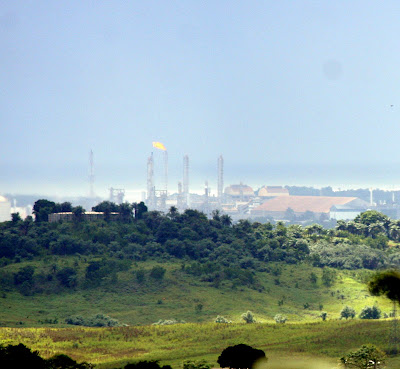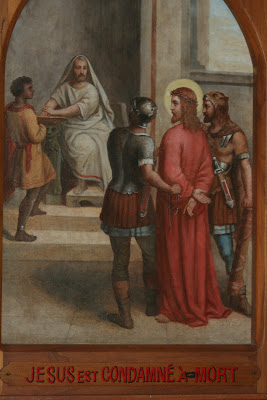Tortuga
The picturesque village of Tortuga sits on the highest point of the Central Range. It is a poignant spot. One of the oldest and most charming churches can be found on this pretty crest.From its cusp, the city of San Fernando and the oil refineries that represent the cogs that drive the nation's economy lie in clear view. The distance makes them seem almost pretty and it is possible to romanticise the slash of flame on the horizon.
The distance makes them seem almost pretty and it is possible to romanticise the slash of flame on the horizon. Tortuga church, as it is commonly known, is the Catholic church of Our Lady of Montserrat built in 1872. This church is best known for its recent restoration work.
 The church had fallen into disrepair and many of its original stained-glass panes depicting biblical scenes were in danger of being lost forever. Elton Rostant, Karen de Verteuil, George de Verteuil, Monica Clement, Simone Taylor, Yvonne Rostant, Clares Batholomew, Franklyn Lee Sam, and Joseph Rostant were the dedicated committee members that worked tirelessly to bring this church built by French priest and architect Fr Marie Jules Dupoux back to its former glory. The end result is something of remarkable beauty.
The church had fallen into disrepair and many of its original stained-glass panes depicting biblical scenes were in danger of being lost forever. Elton Rostant, Karen de Verteuil, George de Verteuil, Monica Clement, Simone Taylor, Yvonne Rostant, Clares Batholomew, Franklyn Lee Sam, and Joseph Rostant were the dedicated committee members that worked tirelessly to bring this church built by French priest and architect Fr Marie Jules Dupoux back to its former glory. The end result is something of remarkable beauty. The restoration of the stained-glass panes was begun in 1991. Mike Watson, the talented craftsman who discovered their existence in 1985, began the meticulous process of restoration in an attempt to preserve the panes before they sucuumbed to further damage. The windows originally came from renowned atelier Henri-Louis Victor Gesta.
The restoration of the stained-glass panes was begun in 1991. Mike Watson, the talented craftsman who discovered their existence in 1985, began the meticulous process of restoration in an attempt to preserve the panes before they sucuumbed to further damage. The windows originally came from renowned atelier Henri-Louis Victor Gesta.Gesta was the son of Louis Victor Gesta, owner of the 19th century’s largest stained glass window-manufacturing firm in the world. The windows, depicting biblical scenes, were made in Toulouse, France, between 1880 and 1890 but were damaged by tropical storm Alma in 1974.

Mike Watson sadly passed away before his work could be completed. His baton was taken over by the committee with Simone Taylor taking an especial interest in the restoration of the windows.

In a 2004 Guardian Newspaper report, the following report was given..... Taylor’s efforts included four trips to France to find the original manufacturer of the windows. In 1995 she visited the atelier of Michael and Daniel Bataillou in Toulouse.
She subsequently enlisted the help of the French Embassy, which sponsored a visit to Trinidad by Daniel Bataillou who provided an estimate for restoring the 20 windows. This figure was roughly $500,000. Undaunted, the Friends continued their fund-raising, eventually taking a loan for $300,000.

In February 2004, the windows were sent to Toulouse, where the Bataillous worked on their restoration. They were aided by Michael Inniss, a glass maker from Trinidad. The French Embassy sponsored a two-month trip in which he was able to learn the process and assist in restoring the windows.
The newly restored glass windows returned to Trinidad in late August and after five days of feverish work, they were reinstalled in their original positions at the church.
The finished product was first seen at the parish festival held on September 5. Parishioners, Gran Couva residents and people from all over the country were able to see the result.
 The rear entrance of the church is reached by climbing rickety wooden stairs that open onto a side room that is the shrine to the much beloved Black Virgin of Montserrat. This Virgin is said to have been brought to the church by early Capuchin monks. She is swathed in a shiny white dress and holds her infant Jesus close to her breast. Her altar is dotted with fresh flowers. I found an excellent article by Paria Publishing online that gives a comprehensive history of this unique madonna.
The rear entrance of the church is reached by climbing rickety wooden stairs that open onto a side room that is the shrine to the much beloved Black Virgin of Montserrat. This Virgin is said to have been brought to the church by early Capuchin monks. She is swathed in a shiny white dress and holds her infant Jesus close to her breast. Her altar is dotted with fresh flowers. I found an excellent article by Paria Publishing online that gives a comprehensive history of this unique madonna.Few genuine relics remain from Trinidad's Spanish period. One of them is to be found in the church dedicated to Our Lady of Montserrat. This little wooden figure of the Blessed Virgin Mary, known as the 'Black Virgin', is said to be a copy of a statue of Our Lady in a shrine in Montserrat, Spain. Port of Spain was probably not founded by the Spaniards at all........ (click to read the entire article)

The view from the churchyard cemetery is serene and peaceful. It overlooks the central plains and is a reminder of how much of Trinidad's beautiful countryside is still undeveloped. In its heyday, this was prime cocoa land and many fortunes were made and lost on the plains of Gran Couva. The cocoa grown in this soil is still recognized as the one of the most superior in the world.


In addition to the beautiful stained-glass windows, the Stations of the Cross in this church are unique in that the captions below each image are all in French.
 The overall effect is beautiful. The beautifully rendered images delivered in French reminds of the strong French Creole influence of the French cocoa planters of the 19th century.
The overall effect is beautiful. The beautifully rendered images delivered in French reminds of the strong French Creole influence of the French cocoa planters of the 19th century.
This church has an extraordinary atmosphere. Yes, there is the overwhelming beauty of the stained glass but there is also a palpable energy that radiates from the Black Virgin. This mixes in with the French Stations of the Cross and captures the complicated relationships that must have been a way of life for the cocoa farmers and their estate workers. I imagined how many planters would have come to this church seeking redemption or reprieve during the crash of cocoa. Just to add a sense of drama, the distant flares of the Pointe-a-Pierre refinery couldn't be more apt. As the old poeple say, after one time, is another.
Other Sources, Writeups, Picks of Lady of Montserrat Church
http://thechutneygarden.blogspot.com/2008/08/tortuga.html
http://www.trinoutdoors.com/pages/religous%20sites.htm#Tortuga_Roman_Catholic_Church
http://www.nalis.gov.tt/Places/places_Tortuga.html
http://trinidad-tobago.strabon-caraibes.org/index.php?option=com_content&view=category&layout=blog&id=12&Itemid=41

No comments:
Post a Comment